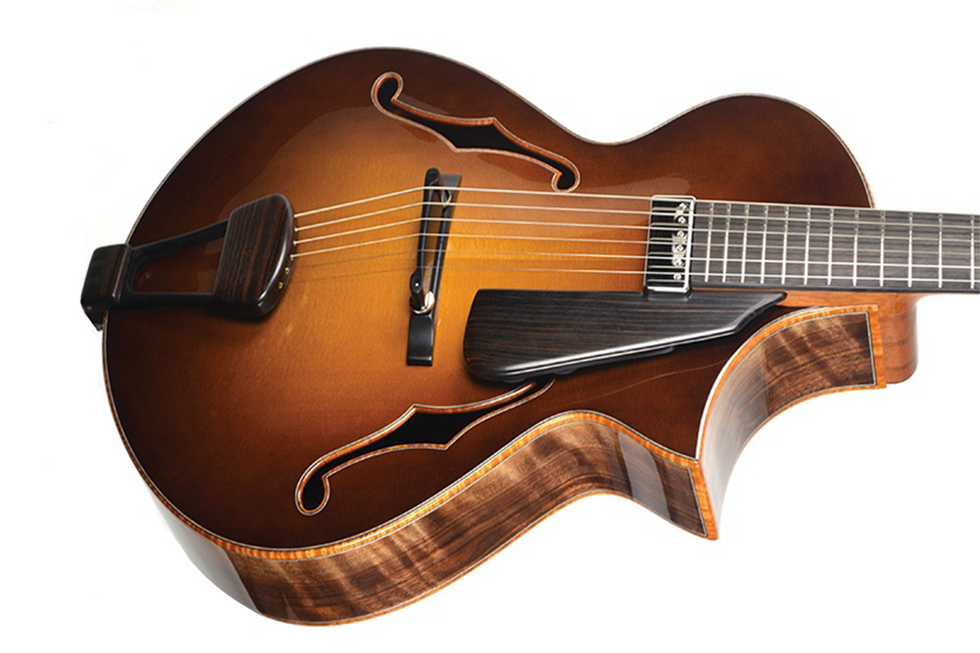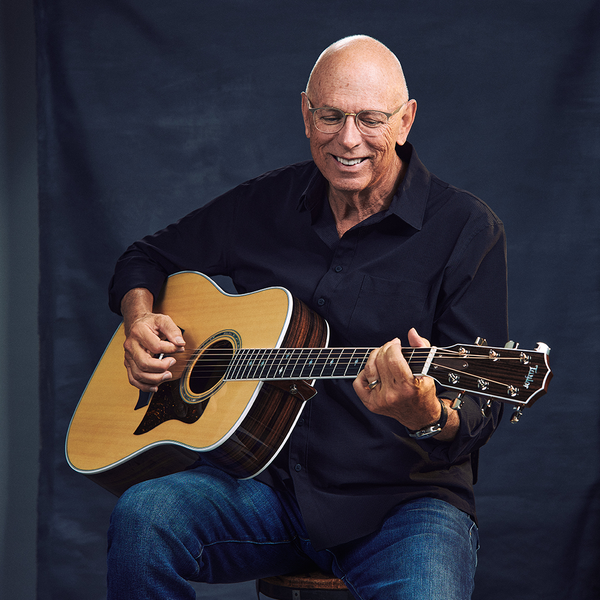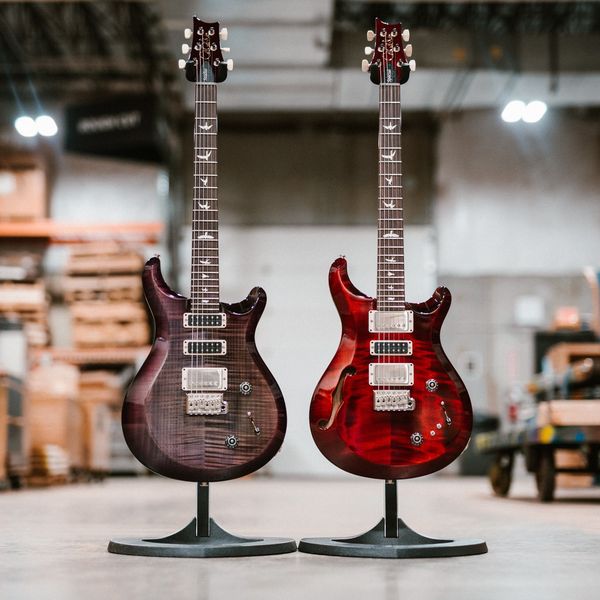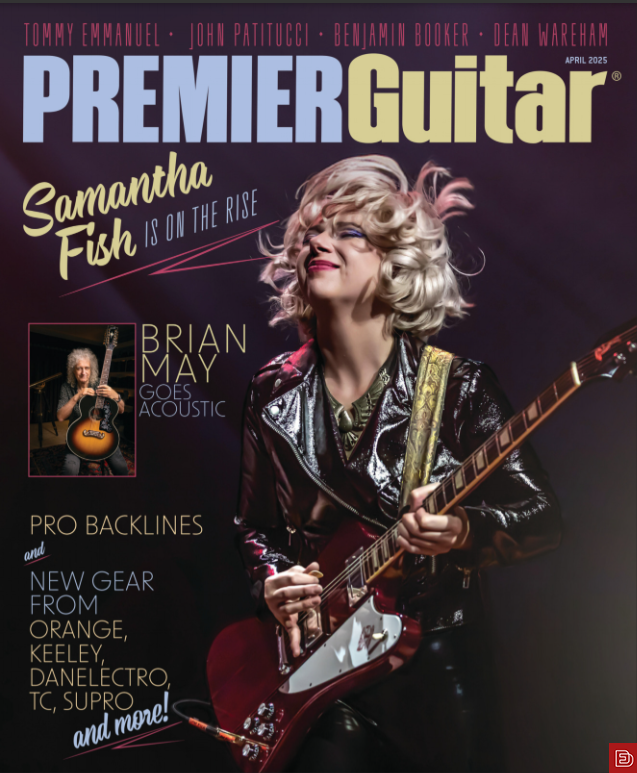
Luthier Maegen Wells recalls the moment she fell in love with the archtop and how it changed her world.
The archtop guitar is one of the greatest loves of my life, and over time it’s become clear that our tale is perhaps an unlikely one. I showed up late to the archtop party, and it took a while to realize our pairing was atypical. I had no idea that I had fallen head-over-heels in love with everything about what’s commonly perceived as a “jazz guitar.” No clue whatsoever. And, to be honest, I kind of miss those days. But one can only hear the question, “Why do you want to build jazz guitars if you don’t play jazz?” so many times before starting to wonder what the hell everyone’s talking about.
Contrary to popular belief, archtop guitars have the potential to be some of the most versatile on the planet. Yet a huge corner of the music world insists on keeping them in a straitjacket. What’s up with that? Even as a little-girl player, I always felt archtops were the most beautiful guitars of them all. So beautiful that they were untouchable. I didn’t need someone to tell me I didn’t play the “right kind of music” to feel unworthy of them. But the word on the street was that archtops were meant for a very particular and sophisticated style of music.
This is not the guitar for you. I believed it. I could feel it. I am not worthy. Instead, I picked up an OM and headed down a very different musical path in life. Tying down the restraints not only on the archtop, but myself. Does this sound familiar?
This is not what music and guitars should do to us. So, who put this straitjacket on? Did I put it on myself? Did I put the archtop guitar in one? Are there others?! Help! How did this happen? I spent the next 11 years walking around in a singer/songwriter straitjacket. It wasn’t until I showed up at the Galloup School of Guitar Building and Repair that I was able to bust out of that thing with some chisels and gouges. It was there that I got my first glimpse at the archtop party.
The first private moment I had with my completed archtop, I was stunned to silence. My soul shifted, and there a song was found hiding—my very first instrumental fingerstyle piece.
My intentions were to be a flattop builder, but I was changed forever when my archtop construction began. Enthralled by the versatility of skills the process demanded, the woodworker in me was ignited. The experience of building a variety of guitars was why I wanted to take the Galloup Masters Program. With that came the experience of playing a variety of guitars that I normally would not play,which was equally educational and life changing—something that has now become essential to my musical inspiration.
The first private moment I had with my completed archtop, I was stunned to silence. My soul shifted, and there a song was found hiding—my very first instrumental fingerstyle piece. I was so hypnotized by the voice of this guitar that it launched me in a completely different musical direction. I did not sing another note for almost 7 years; this instrument’s voice was the only one I wanted to hear. It was everything I’ve ever wanted: acoustic, electric, sensitive, powerful, delicate, strong. Our love was effortless, and it found music living inside of me that I had no idea existed. Isn’t that what it’s all about?
I share this dusty story with you today because I know I’m not alone. There are others out there who have allowed the restraints to come between them and these remarkable instruments. Because at some point along the way, they were told they’re not supposed to do that with an archtop. I hear this all of the time. Whatever happened to just picking up a guitar, closing your eyes, and letting it pull something out of you? I’m not at all denying the fact that certain instruments excel with certain genres and styles of playing, but we can’t let that prevent us from exploring the things we’re curious about.You could be missing out on one of the great loves of your life.
I almost missed out on the archtop party, but thankfully I came in through the woodshop window. And I have good news: The others at this party are on a similar mission to free the archtop from its straitjacket. Not to mention, the music at this party is off the hook. Is there jazz? YES! But that’s not all—we have fingerstyle, honky-tonk, funk, blues, rock, weird space music, and everything else you’re not supposed to do on an archtop. With today’s premier archtop builders such as Danny Koentopp, Tim Frick, Wyatt Wilkie, LHT, Otto D’Ambrosio, or Retrograde, just to name a few, there is undoubtedly something for everyone to be inspired by.
This is your official invitation to the archtop party. Leave your straitjacket at the door and join us, ’cause an archtop party don’t stop.
- Review: Godin 5th Avenue Archtop - Premier Guitar ›
- Eastman AR371CESB Archtop Review - Premier Guitar ›
- Godin Guitars Releases New Archtop Acoustic - Premier Guitar ›
- Retrograde Guitars' Glenn Nichols Talks Muddy Waters - Premier Guitar ›
- Retrograde Guitars' Glenn Nichols Talks Muddy Waters - Premier Guitar ›
- Why Guitar Builders Blend Tonewoods - Premier Guitar ›
Brent Mason is, of course, on of the most recorded guitarists in history, who helped define the sound of most ’90s country superstars. So, whether you know it or not, you’ve likely heard Mason’s playing.
Professional transcriber Levi Clay has done the deepest of dives into Brent Mason’s hotshot licks. At one point, he undertook the massive project of transcribing and sharing one of Mason’s solos every day for 85 or so days. Mason is, of course, on of the most recorded guitarists in history, who helped define the sound of most ’90s country superstars. So, whether you know it or not, you’ve likely heard Mason’s playing. Levi shares the insight he gleaned from digging deep, and he tells us what it was like when they shared a stage last year. Plus, Levi plays us some great examples of Mason’s playing.
For the first time ever, two guitar greats, John 5 and Richie Kotzen will be heading out on the road this year. The tour will launch October 16 and run through November, hitting markets across the U.S.
Find the full tour itinerary right plus a link for tickets & VIP, including additional dates featuring John 5 only. Reserved seating tickets will go on sale Friday May 16 though a fan presale will begin today at noon local time and fans are strongly encouraged to buy early to get the best seats.
Meet and Greets for both artists will be available. For John 5 please go to: https://john5store.com/collections/vip.
Today, John 5 also announces more details of his anticipated new album. Called The Ghost, it will be released October 10 and is led by the new track “Fiend,” featuring Kenny Aronoff.
John 5 continues running public tours this month for his Knights In Satan’s Service Museum of KISS Memorabilia in Los Angeles, California. Guided tours are open to the public for one month only (with a possible expansion). Current dates available are May 12-16, May 19-23 and May 27-30. Each will be led by John 5 himself who will provide tons of rich detail and answer any questions. Secure your place HERE.
JOHN 5 continues to tour with Mötley Crüe including an upcoming residency in Las Vegas in 2025.RICHIE KOTZEN &
JOHN 5 FALL 2025 TOUR
October 16 El Cajon, CA @ Magnolia
October 17 Riverside, CA @ Fox Performing Arts
October 18 Roseville, CA @ Goldfield Trading Post
October 19 San Jose, CA @ The Ritz
October 21 Phoenix, AZ @ Celebrity Theatre
October 22 Albuquerque, NM @ KiMo Theatre
October 24 Dallas, TX @ Granada Theater
October 25 Leander, TX @ The Haute Spot
October 27 New Orleans, LA @ House of Blues
October 28 Memphis, TN @ Minglewood Hall
October 29 Nashville, TN @ Fogg Street Lawn Club
October 30 Atlanta, GA @ Variety Playhouse
October 31 Orlando, FL @ House of Blues
November 1 Fort Lauderdale, FL @ Culture Room
November 2 Clearwater, FL @ Capitol Theatre
November 4 Richmond, VA @ The National
November 5 Leesburg, VA @ Tally Ho Theater
November 6 Patchogue, NY @ Patchogue Theatre
November 11 Glenside, PA @ Keswick Theatre
November 12 Derry, NH @ Tupelo Music Hall
November 13 Foxborough, MA @ Six String Grill & Stage
November 14 Stroudsburg, PA @ Sherman Theater
November 15 Lorain, OH @ Lorain Palace Theatre
November 16 Columbus, OH @ The King Of Clubs
November 17 Warrendale, PA @ Jergels
November 19 Wyandotte, MI @ District 142
November 20 Flint, MI @ The Machine Shop
November 21 Fort Wayne, IN @ Piere’s
November 22 St. Charles, IL @ Arcada Theatre
November 23 Belvidere, IL @ Apollo Theatre
November 25 Denver, CO @ Oriental Theater
November 29 Pioneertown, CA @ Pappy & Harriet's*
*John 5 only
AEROSMITH guitarist and songwriter JOE PERRY is set to return to the road for a series of August performances with THE JOE PERRY PROJECT. The 8-date run kicks off August 13 in Tampa, FL and wraps August 23 in Port Chester, New York, with an August 19 performance in PERRY’s Boston hometown (see the itinerary below). For the North American trek—which marks the first solo shows for PERRY this year—the legendary guitarist will be joined by his Aerosmith bandmates Brad Whitford (guitar) and Buck Johnson (keys), along with The Black Crowes’ Chris Robinson (vocals), and Stone Temple Pilots’ Robert DeLeo (bass), and Eric Kretz (drums).
“Well…it’s time to let the music do the talkin again,” PERRY says. “I’m really excited about the JPP line up this year!!!! Most of these guys played with me at The Roxy in L.A. at the debut event for my latest solo album [Sweetzerland Manifesto] in January 2018. They’re all busy as hell but thankfully they’re able to carve out some time for this run. And I’m not only lucky enough to have Brad Whitford onstage with me but Chris Robinson of The Black Crowes! [who sang ‘Fortunate One’ on Sweetzerland Manifesto MKII], Robert DeLeo and Eric Kretz from STP!!! and Buck Johnson who plays keys and sings with Aerosmith, the Hollywood Vampires, and is also a solo artist in his own right.”
For the shows, the Rock and Roll Hall of Fame inductee says “the set list is gonna include my fav JPP cuts, STP, Black Crowes, and with Brad we’ll be hitting the Aero hits and some deep cuts and then ya never know!!!! Gonna be a BLAST, and if you’ve ever been to one of my shows you know the words GARAGE BAND on STEROIDS come to mind! See you there!!!!”
DATE | LOCATION | VENUE |
Wednesday, August 13 | Tampa, FL | Seminole Hard Rock - Tampa |
Thursday, August 14 | Hollywood, FL | Seminole Hard Rock - Hollywood |
Saturday, August 16 | Toronto, ON | HISTORY |
Sunday, August 17 | Muskoka, ON | Kee to Bala |
Tuesday, August 19 | Boston, MA | Wang Theatre |
Wednesday, August 20 | Hampton Beach, NH | Hampton Beach Casino Ballroom |
Friday, August 22 | Mashantucket, CT | The Premier Theater at Foxwoods Resort Casino |
Saturday, August 23 | Port Chester, NY | Capitol Theatre |
A sample page from the author’s analog log.
Seasonal changes are tough on your acoustic. Here’s how you can take better care of your prized instrument.
As you read this, spring is in bloom in most of the US, or maybe it has been for some time. I’m timing this column specifically to ask acoustic guitarists, in this season of increasing humidity and comfortable conditions, to prepare for what’s coming. It’s never too soon, and time flies. Before you know it, we’ll be back to the maintenance phase and you might be blowing up the phones of your local guitar shops, luthiers, and techs. I’m here to encourage a decidedly old-school approach to preventative guitar maintenance, and yes, it starts now.
Why, you ask? Well, as the lead luthier at Acoustic Music Works, I can tell you that in my nearly 15 years in this position, this was the worst winter ever for preventable repairs on acoustic guitars. Fret sprout, bridge lifts, top sink, soundboard cracks, back cracks, loose binding, general malaise… These hit us very hard in the winter that spanned 2024 and 2025. Am I complaining? On the one hand, no. This is part of how we make our money. On the other hand, yes! Repair schedules related to dryness and humidity issues can stretch into weeks and even months, and nobody wants to be without their favorite instruments for that amount of time. With a little thoughtfulness, however, you might get through next winter (and every one thereafter) without hefty repair bills or time apart from your musical companion.
Our preparation is going to start with an unlikely but very important guitar accessory: the humble notebook. Plain, lined, grid, day planner… it doesn’t matter. We all need to actively participate in our instrument maintenance, and in my experience, fancy apps that track humidity via Bluetooth breed a kind of laziness, a feeling of safety that might prevent us from actually physically looking in on conditions. Better we keep an analog, well, log, so that we know where things stand, and I suggest checking in daily.
“This was the worst winter ever for preventable repairs on acoustic guitars.”
Track your relative humidity, both in the case and in the room where your instruments mostly reside, but also take notes on your action height, top deflection (StewMac has some great tips for measuring this) and anything related to playability that you believe you can observe empirically.
Dryness is the root cause of most guitar issues that manifest in the fall and winter months. Symptoms of dryness include sharp fret ends, falling action and dead frets, sunken top around the sound hole, and cracks and bridge lifts. With your trusty notebook, you’ll get a feel for the sensitivity level of your instrument, and that knowledge is power!
A few other basic implements will not only assist you in your observations, but may also satisfy your need to buy guitar-related things (at least for a minute). Getting quick and comfortable with a fret rocker is a great skill to have, and is invaluable in diagnosing buzzes due to high frets or frets that have come unseated due to dryness. A well-calibrated relief gauge might seem luxurious, but it can prevent you from making unnecessary or extreme truss rod adjustments. A string action gauge, or even a simple machinist’s rule or set of feeler gauges, will help you keep track of your action. Get a three-pack of hygrometers so you can average their readings, rather than depending on one.
Lest we forget: A guitar can not only be too dry, it can also be too wet. By beginning your maintenance diligence in the spring/summer, you’ll also be able to tell if your instrument is the victim of a too-humid environment. The signs of over-humidification are subtle: Your action may rise from a puffed-up top, and in extreme cases, glue joints could begin to fail. In my experience, an over-humidified guitar will suffer from dulled tone, almost like a sock in the sound hole. If you’re sensing a lack of clarity in your guitar all of a sudden, start with new strings. If it persists, it might be due to over-humidification, and you may want to introduce a desiccant to the case for a time. The more lightly built your guitar is, the more sensitive it will be to seasonal changes.
By getting into these habits early, you’ll be empowered by knowing your instrument more intimately. You’ll understand when and why changes in tone and playability might have occurred, and you’ll hopefully save on repair bills year-round. Feel free to reach out with any questions. Who knows? I might just send you a notebook with an AMW sticker on the cover!





